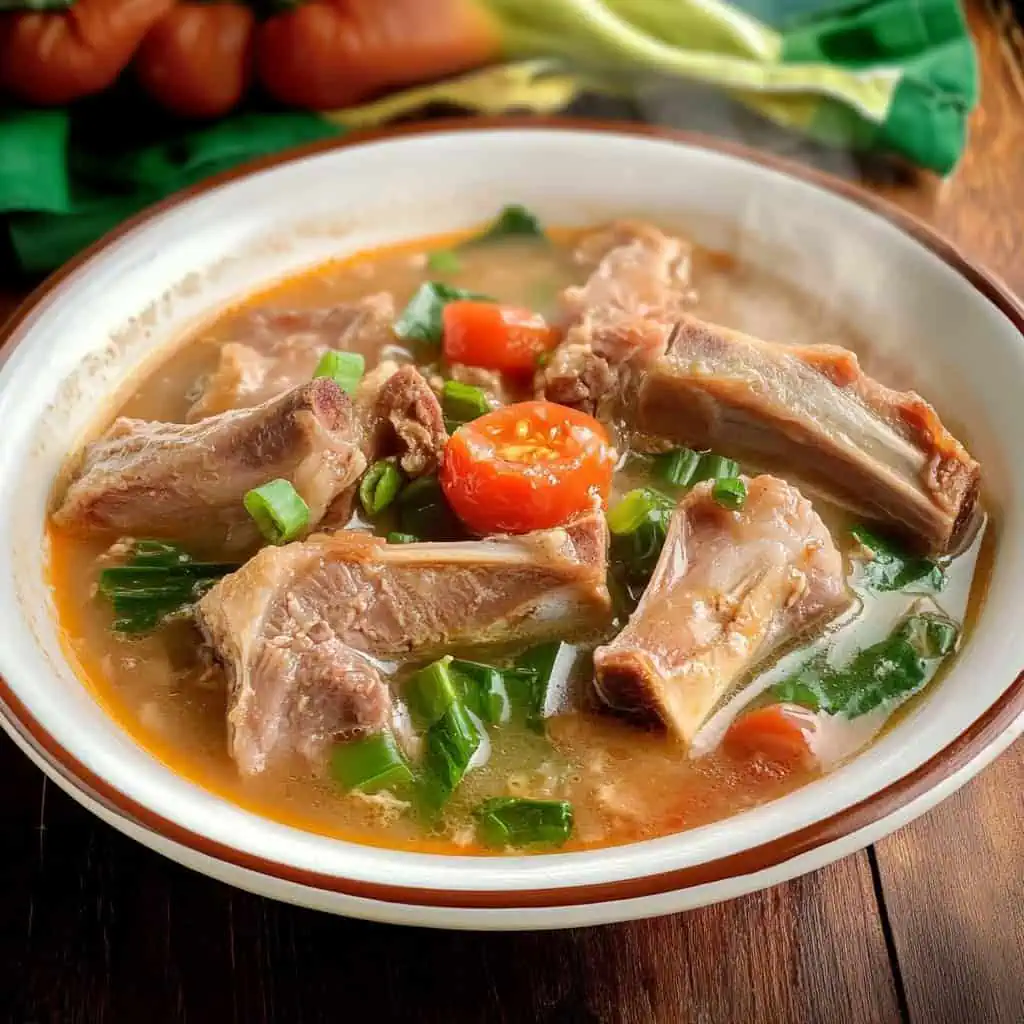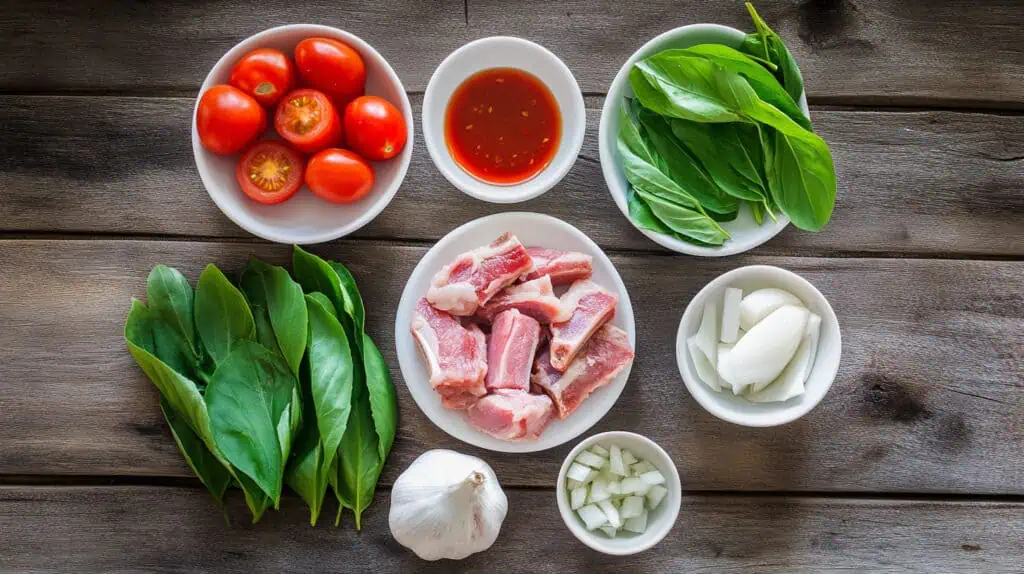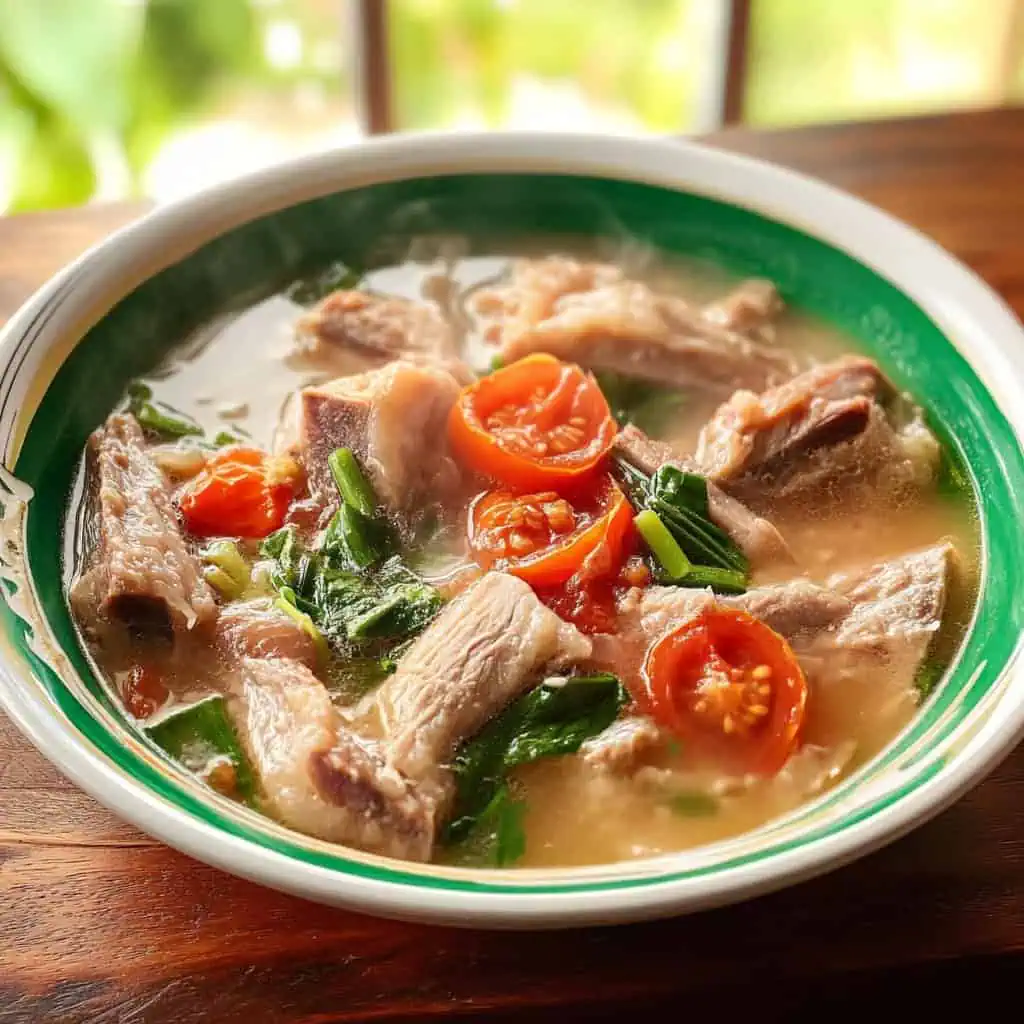Need a cozy, home-cooked meal without the fuss? This Kinamatisang Baboy is your answer. It's one of those Filipino recipes that proves amazing food doesn't need fancy ingredients or complicated steps, just good, simple cooking.
Think tender pork ribs swimming in a light tomato broth that practically makes itself while you go about your day. I love making this on busy weeknights or lazy weekends. Just toss everything in a pot, let it simmer, and before you know it, you've got a soup that tastes like it came straight from a Filipino grandmother's kitchen.
Perfect for rainy days, cold evenings, or honestly, any time you're craving something comforting but don't want to deal with kitchen chaos.
What is Kinamatisang Baboy?
Kinamatisang Baboy is a rustic Filipino soup where pork ribs are simmered with ripe tomatoes until tender, creating a light yet satisfying broth enriched with umami from fish sauce and finished with fresh pechay greens. The name "kinamatisan" derives from "kamatis" (tomatoes), reflecting the dish's core ingredient that provides both flavor and body to this homestyle comfort food.
Jump to:

Why You'll Love This Recipe
- Effortless comfort food perfect for cold weather
- One-pot meal that's both nutritious and filling
- Budget-friendly yet packed with flavor
- Rich in vitamins C and A from fresh tomatoes and pechay
- Versatile recipe that works with different meat cuts
- Simple ingredients you can find at any grocery store
Ingredients
The ingredients in Kinamatisang Baboy create perfect harmony in your bowl. Pork ribs provide rich flavor and become fall-apart tender during slow simmering. Ripe tomatoes are the star, breaking down to create a naturally sweet and slightly tangy broth without needing additional souring agents.
Fish sauce adds that crucial umami depth that makes the soup satisfying rather than watery. Onions and garlic form the aromatic foundation, while fresh pechay adds a pop of color, texture, and nutrition at the finish.
Together, these simple ingredients transform into something greater than their parts, a comforting soup that tastes complex despite its straightforward preparation.

For the Base:
- 3 pounds pork spare ribs, cut into 2-inch pieces
- 5 large Roma tomatoes, quartered
- 1 medium onion, peeled and chopped
- 3 cloves garlic, peeled and minced
- 1 tablespoon cooking oil
- 1 tablespoon fish sauce
- 6 cups water
- Salt and pepper to taste
For the Vegetables:
- 2 bunches pechay (Chinese cabbage), cut into thirds
- 2-3 finger chilies (optional)
Equipment
- Large heavy-bottomed pot - For even heat distribution and preventing burning
- Sharp knife - For cutting meat and vegetables precisely
- Cutting board - For safe and clean food preparation
- Large spoon or ladle - For stirring and serving the soup
- Skimmer or strainer - For removing scum during cooking to keep the broth clear
- Measuring cups and spoons - For accurate ingredient measurements
- Meat thermometer - To ensure pork reaches the safe internal temperature of 145°F

How To Make
- Heat oil in a large pot over medium heat. Add chopped onions and minced garlic, cooking until the onions become transparent and soft, about 3 minutes. Add the pork ribs and cook, stirring occasionally, until the meat changes color and is no longer pink, around 5-7 minutes.
- Add the quartered tomatoes and cook until they begin to soften and release their juices, about 3-4 minutes. Pour in the fish sauce and stir for 1 minute to combine the flavors. Add 6 cups of water and bring everything to a gentle boil.
- Once boiling, reduce the heat to low, cover the pot, and let it simmer. As foam or scum rises to the top, gently skim it off with a spoon to keep the broth clear. Continue simmering for 50-60 minutes, or until the pork is tender enough to easily pierce with a fork. If needed, add water in half-cup portions to maintain the liquid level.
- When the meat is tender, add the pechay pieces to the pot. Cook for just 1-2 minutes until the greens are wilted but still bright green. Taste the broth and add salt and pepper as needed. Serve hot in bowls with steamed rice on the side.
Note: The pork is done when it reaches an internal temperature of 145°F (63°C) and is fork-tender. For best results, use very ripe tomatoes as they provide natural sweetness and break down more easily into the broth.

Tips from Lola's Kitchen
- Choose pork ribs with good marbling - The fat content adds richness and depth to your broth
- Be patient with simmering - Low and slow cooking develops complex flavors that can't be rushed
- Brown the meat properly before adding tomatoes for deeper flavor development
- Skim diligently - Taking the time to remove scum results in a clearer, more appetizing broth
- Use the ripest tomatoes possible - They'll break down better and add natural sweetness
- Add fish sauce gradually - Start with the recommended amount, then adjust to taste at the end
- Don't overcook the pechay - Add it last minute to keep its bright color and nutrients intact
- Let the soup rest for 5-10 minutes before serving to let flavors settle and meld together
Substitutions
- Meat options: If pork isn't available, use chicken thighs (bone-in for best flavor), beef short ribs, or even fish chunks for a lighter version
- Greens alternatives: Bok choy, spinach, or mustard greens work well instead of pechay
- Tomato substitutes: In a pinch, use canned whole tomatoes (drain excess liquid)
- Fish sauce alternatives: Sea salt or light soy sauce can work, though the flavor profile will change slightly
- Low-sodium version: Use low-sodium broth instead of water and reduce the fish sauce
- Aromatics: Add ginger slices for warmth or lemongrass for a citrusy note
Troubleshooting
- Tough meat: If your pork isn't tender after the recommended cooking time, continue simmering in 15-minute increments until fork-tender. Different cuts and qualities of meat may require longer cooking.
- Watery broth: Remove the lid and simmer uncovered for 10-15 minutes to reduce and concentrate flavors.
- Bland taste: Add fish sauce 1 teaspoon at a time, allowing it to incorporate before tasting again. Remember that salt enhances the natural flavors already present.
- Cloudy broth: Be more vigilant about skimming foam during the initial simmering phase. For very clear broth, strain through cheesecloth before serving.
- Greasy surface: Allow the soup to cool slightly, then skim off excess fat with a large spoon or specialized fat separator.
- Mushy vegetables: Only add pechay in the final 1-2 minutes of cooking. If reheating leftovers, consider adding fresh greens rather than reheating the existing ones.
Storage & Reheating
- Refrigeration: Store in an airtight container for up to 3 days. The flavor often improves overnight as ingredients meld.
- Freezing: Freeze without the pechay for up to 2 months. Leave some headspace in containers as soup expands when frozen.
- Thawing: Thaw overnight in the refrigerator for best results.
- Stovetop reheating: Warm over medium-low heat until it reaches 165°F (74°C), stirring occasionally. Add fresh pechay if desired.
- Microwave reheating: Heat on medium power for 2-3 minutes, stirring halfway through. Cover with a microwave-safe lid to prevent splattering.
- Refreshing leftovers: Add a splash of fresh water and a few drops of fish sauce to revive flavors. Consider adding fresh herbs or a squeeze of citrus when serving.

FAQ
Can I make this in a slow cooker or pressure cooker?
Yes! For slow cookers, cook on low for a 6-8 hours. For pressure cookers or Instant Pots, cook on high pressure for 30 minutes with natural release. Add the pechay after pressure cooking.
Why is my broth not as red or flavorful as expected?
This could be due to using underripe tomatoes. Make sure to use fully ripe, preferably Roma tomatoes, and allow them to cook down properly before adding water.
Can I add other vegetables to this soup?
Absolutely! String beans, daikon radish, or corn on the cob are traditional additions. Add harder vegetables earlier in the cooking process and adjust cooking times accordingly.
How do I know when the pork is done?
The pork should be fork-tender (easily pierced and starting to fall off the bone) and reach an internal temperature of 145°F. Cooking time may vary depending on the cut and size of meat.
Is this soup freezer-friendly?
Yes, but freeze without the pechay as leafy greens don't freeze well. Add fresh greens when reheating for best texture and appearance.
Can I make this dish ahead for a party?
This soup actually improves in flavor overnight, making it perfect for advance preparation. Reheat gently and add fresh pechay just before serving.
What can I serve with Kinamatisang Baboy?
Traditionally served with steamed white rice. Some Filipinos also enjoy it with a side of fish sauce (patis) for extra seasoning or calamansi halves for squeezing over the soup.
Is this recipe suitable for meal prep?
Yes! Prepare a large batch and portion into individual containers for quick meals throughout the week. The flavors continue to develop over time.
Related
Looking for other recipes like this? Try these:

Kinamatisang Baboy (Filipino Tomato-Based Pork Soup)
Equipment
- Large heavy-bottomed pot (kaldero) For even heat distribution and preventing burning
- Sharp knife (kutsilyo) For cutting meat and vegetables
- Cutting board (Sangkalan) For prep work
- Large spoon or ladle (sandok) For stirring and serving
- Skimmer or strainer For removing scum during cooking
- Measuring cups and spoons (Panukat) For precise measurements
- Meat thermometer To ensure proper cooking temperature
Ingredients
For the Base
- 3 pounds pork spare ribs tadyang ng baboy, cut into 2-inch pieces
- 5 large Roma tomatoes kamatis, quartered
- 1 medium onion sibuyas, peeled and chopped
- 3 cloves garlic bawang, peeled and minced
- 1 tablespoon cooking oil
- 1 tablespoon fish sauce patis
- 6 cups water tubig
- Salt asin at paminta, to taste
For the Vegetables
- 2 bunches pechay Chinese cabbage, cut into thirds
- Optional: 2-3 finger chilies siling haba
Instructions
- Heat oil in a large pot over medium heat. Add chopped onions and minced garlic, cooking until the onions become transparent and soft, about 3 minutes. Add the pork ribs and cook, stirring occasionally, until the meat changes color and is no longer pink, around 5-7 minutes.
- Add the quartered tomatoes and cook until they begin to soften and release their juices, about 3-4 minutes. Pour in the fish sauce and stir for 1 minute to combine the flavors. Add 6 cups of water and bring everything to a gentle boil.
- Once boiling, reduce the heat to low, cover the pot, and let it simmer. As foam or scum rises to the top, gently skim it off with a spoon to keep the broth clear. Continue simmering for 50-60 minutes, or until the pork is tender enough to easily pierce with a fork. If needed, add water in half-cup portions to maintain the liquid level.
- When the meat is tender, add the pechay pieces to the pot. Cook for just 1-2 minutes until the greens are wilted but still bright green. Taste the broth and add salt and pepper as needed. Serve hot in bowls with steamed rice on the side.
- Note: The pork is done when it reaches an internal temperature of 145°F (63°C) and is fork-tender. For best results, use very ripe tomatoes as they provide natural sweetness and break down more easily into the broth.
Tips from Lola's Kitchen
- Choose pork ribs with marbling for better flavor
- Don't rush the simmering process - this develops the broth's flavor
- Add tomatoes only after meat has browned for better caramelization
- Remove scum as it appears for clearer broth
- Use very ripe tomatoes (hinog na kamatis) for natural sweetness
Nutrition
The Story Behind Kinamatisang Baboy
Deep in the heart of Filipino home cooking lies Kinamatisang Baboy, a dish that beautifully represents the resourceful and practical nature of our local cuisine. This hearty soup traces its roots to rural Filipino kitchens, where families would make the most of abundant local tomatoes during harvest season. Unlike its more famous cousin sinigang, which gets its sourness from tamarind or other fruits, kinamatisan relies purely on the natural flavors of ripe tomatoes to create its signature light yet satisfying broth.
The name itself tells a story – "kinamatisan" comes from the Filipino word "kamatis" (tomatoes), with the prefix "kina-" suggesting a cooking method where tomatoes are the star. It's a testament to how Filipino cooks have long understood the magical transformation that happens when sweet, ripe tomatoes slowly simmer with meat, creating a broth that's both nourishing and delicious. This cooking method has been passed down through generations, with each family adding their own special touch while keeping the essence of the dish intact.
What makes this recipe particularly special is its status as true Filipino comfort food. You'll find it bubbling away on stovetops across the country, especially during the rainy season when the weather calls for something warm and comforting. Home cooks love it because it's economical and forgiving – you can use different cuts of pork, add whatever vegetables are in season, and adjust the broth to your family's taste preferences. It's the kind of dish that fills your kitchen with warm, inviting aromas and brings everyone to the table eager to dig in.
In today's fast-paced world, Kinamatisang Baboy remains a favorite among busy Filipino families. It's a one-pot wonder that delivers the flavors of traditional home cooking without requiring complicated techniques or hard-to-find ingredients. Whether served for a weekday dinner or a weekend family gathering, this dish continues to tell the story of Filipino culinary heritage – one that values simplicity, resourcefulness, and the power of food to bring people together.
The beauty of this dish lies not just in its flavors but in its adaptability. While the basic recipe remains constant – pork, tomatoes, and leafy greens in a savory broth – each region and family in the Philippines might prepare it slightly differently. Some add ginger for warmth, others include corn for sweetness, and many have their own special blend of seasonings. This versatility has helped Kinamatisang Baboy evolve from a simple rural dish to a beloved staple of modern Filipino cuisine, proving that sometimes the most humble recipes become the most enduring classics.










Comments
No Comments